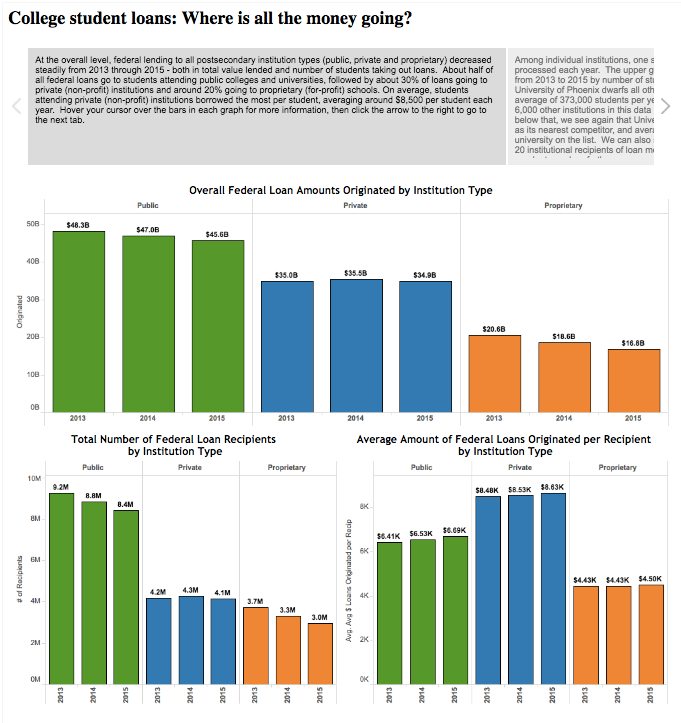College affordability: What you need to know about this important barrier to postsecondary education
8/24/2016
As we enter the time of year when many Duval County high school graduates will be starting their first days of college, we also enter a time when many students are faced with stressful decisions about how to afford a college education.
A recent report published by the Brown Center on Education Policy surfaced some important high-level findings for both students approaching college and all of us concerned about the impact of student debt on the larger economy.
Researchers focused on differences in demographics (including work and life dynamics) and borrowing behaviors between students attending different types of colleges and universities, including: public, non-profit private, and for-profit institutions.
Overall, some key findings included:
-
For-profits had higher proportions of female and minority students enrolled. Students at for-profits also tended to be older at date of first enrollment and more likely to have served in the military or be single parents.
-
For-profit students also tended to come from families with lower rates of parental education levels than students at other types of institutions.
-
Private (non-profit) institutions had by far the highest average annual costs in terms of tuition and fees (avg. $21,561/year), followed by for-profits (avg. $10,215/year) and then public institutions with the lowest average costs (4-year avg. $6,832/year; 2-year avg. $1,556/year).
-
For-profit students tended to be from lower income backgrounds. For-profit students also tended to borrow at much higher levels than students in comparable public programs, largely due to the higher costs of for-profits than public institutions. As the authors state:
“Based on needs and resources, for-profit students are most similar, but in many ways still less affluent, than public two-year students who pay much lower costs. For-profit students have the lowest average annual household income, at just $28,530, and are closest, on average, to the poverty line. Even public two-year students seem to be much better off than their for-profit counterparts, with incomes averaging $41,718. … As expected from our descriptive analysis, the relatively high for-profit cost (mostly tuition) is by far the largest predictor of this explained variation, accounting for nearly all the difference in borrowing rates. This finding implies that for-profit student borrowing would be lower if costs were more similar to those in public community colleges (pp. 9-11).”
The full report is available here and has much more information on borrowing trends and patterns between students at each of these different types of colleges and universities overall, but we also wanted to drill down a little deeper and try to find out where – more specifically – all that money is going.
In the visualization below, click through a series of summaries and interactive dashboards that will allow you to drill down into and explore where the nearly $300 billion in student loans the federal government disbursed from 2013 to 2015 went.
The storyboard tabs above each visualization offer a few high-level takeaways of what each look reveals, but there is a ton of data to explore here, so please do and let us know in the comments what else you discover.
Danae Sparks, a rising senior at Paxon School for Advanced Studies, who came to the Jacksonville Public Education Fund this summer to complete her volunteer hours for graduation, shared her perspective on securing financial aid for college:
College is the ultimate goal for me, that is the only reason I go through the stress, anxiety, sleep deprivation, and countless amount of hours dedicated to studying and doing homework. But when you’re a senior in high school and you realize college is around the corner, just the thought of college stresses you out! Where am I going? What am I majoring in? Will I change my major? Am I getting a scholarship? Can I afford it? Is this really what I want to do? These are the few questions that come to mind when thinking about college.
Applying for scholarships is a step many of us will need to take in order to get more money for school or other things we need. There are thousands of scholarships for many different things that will most likely fit every student in DCPS but finding them is sometimes a challenge. Websites like fastweb.com and scholarships.com are easy to use, reliable, and secure websites to use. Guidance counselors and teachers are dependable people to ask about certain scholarships, the qualifications, and they can also help with certain things you might need to apply with such as essays and transcripts.
Schools provide a lot of insight about college like the amazing experience, tons of educational opportunities, and how it will better your chances at finding a career, etc. it’s still a worrisome topic because these are the most important years of your life and as a teenager you sort of have a plan of what you want your life to look like when you grow older and if you make the wrong decision, it could change everything.
